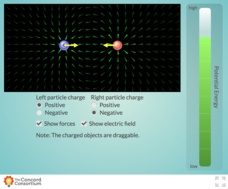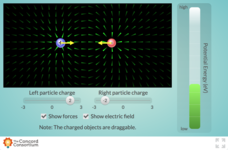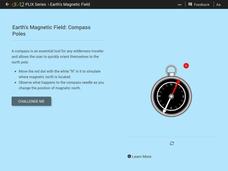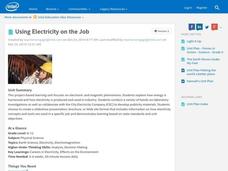Rice University
College Physics for AP® Courses
Take a look at an organized physics course. The 34-section electronic textbook covers material in AP® Physics 1 and 2. Teachers use the text to supplement lectures and have the class work through the labs. Each section contains multiple...
PHET
Faraday's Law
Could a flux capacitor really work? An engaging simulation encourages scholars to investigate Faraday's law. They experiment with various speeds, magnitude, voltage, and different-sized coils. Hopefully experimenters will be able to...
PHET
Simplified MRI
Cancerous tissues contain more water than normal tissue, which causes the cancerous tissue to resonate longer on the screen and be seen. High school learners can see how MRIs detect tumors in someone's head. Radio transmitters emit their...
College Board
AP Physics 1 and 2 Inquiry-Based Lab Investigations
Have you ever wondered what type of AP Physics investigations The College Board wants? This is the guide for you! Sixteen labs covering both Physics I and II will get you started and inspire you to meet the requirement of 25 percent of...
Bonneville
Macro-Scale Solar
There's no substitute for the power of the sun. The second of four installments of the Solar Resources Assessment unit looks at macro-scale photovoltaic (PV) technology. Future scientists first learn about PV modules with a PowerPoint...
Bonneville
Introduction to the Photovoltaic Effect
Let a video light the way to a better understanding of solar energy. Scholars first learn vocabulary terms related to the photovoltaic effect, solar cells, and electricity. They then watch a video to learn why silicon is often used as a...
Physics Classroom
Electric Field Intensity
Learning about electrostatics can be pretty intense! Physics fanatics explore the factors that affect electric field intensity using an interactive from the Static Electricity series. Learners work to complete data tables that relate...
Kenan Fellows
Climate Change Impacts
Turn up the heat! Young mathematicians develop models to represent different climates and collect temperature data. They analyze the data with regression and residual applications. Using that information, they make conclusions about...
National Nanotechnology Infrastructure Network
Hiding Behind the Mask
Microchips are a man-made wonder. Investigate the manufacturing wonder with a hands-on inquiry-based lesson. Scholars simulate the process of pattern transfer using photoresist. Their conclusion identifies how their process replicates...
Cornell University
Electromagnets
Discover the connection between electric current and magnets. Scholars create electromagnets by passing a magnet through a coil. They experiment with different materials to determine the variables that affect the strength of the current.
Concord Consortium
Electric Potential Energy and Type of Charge
Scholars are sure to get a charge out of an electric lesson! They examine the potential energy of charged particles while they make changes to the electrical field. The simulation allows them to change the position of particles and the...
Concord Consortium
Electric Potential Energy and Charge Intensity
Does the charge on a particle affect its energy? Scholars first explore how the strength of a charge affect the potential energy. They observe the change in the electric fields as this potential energy changes.
Concord Consortium
Target Game—Distance/Force Relationship
Explore the relationship between the distance and the force of charged particles. Scholars adjust the location of charged particles to change the path of a launched particle. By displaying the electric field, they can make a connection...
Concord Consortium
Target Game—Charge Magnitude/Force Relationship
Build an electric field to direct a charged particle to a target. Scholars determine how location and strength of charge affect the electric field that surrounds the object. They complete two challenges to strengthen their understanding.
Concord Consortium
Target Game—Free Play
Challenge your classes to use electric fields to hit a target. Scholars place positively and negatively charged particles on a game board to direct a charged particle to a target. They can choose to view the electric field and force on...
CK-12 Foundation
Earth's Magnetic Field: Compass Poles
You'll be strangely drawn to this activity! Physical science pupils learn how compasses work in an interesting interactive. The content covers magnetic poles, Earth's magnetic field, and what would happen if Earth's poles swapped places.
CK-12 Foundation
Electric Motor
How does a direct current run a motor? Pupils control five variables in an electric motor and observe how the force diagram changes. The force, magnetic field, and current vary based on the changes in the design of the magnet and motor....
CK-12 Foundation
AC Transformer
High voltage power lines deliver electricity to homes, but each home requires low voltage. How does the energy get converted so it can be used safely? Pupils explore alternating current and transformers through a simulation. They control...
CK-12 Foundation
Doorbell
What are some simple uses for an electromagnet? Scholars explore the electromagnetic circuitry in a doorbell through an interesting simulation. They control the core material, number of loops, amount of current, and strength in a spring....
CK-12 Foundation
Galvanometer
In 1820, Hans Christian Orstead discovered the link between electricity and magnetism, which allows us to measure current and voltage. The simulation allows scholars to observe the inner workings of an ammeter and voltmeter as they...
CK-12 Foundation
Telegraph
Most pupils don't know what a telegraph is, much less how one works. A secret simulation has scholars pick the size of the primary and secondary loops, the battery voltage, and which letters in the Morse Code they want to transmit. They...
PHET
Generator
Michael Faraday was self-educated, earned an honorary doctorate from the University of Oxford, invented the first Bunsen burner, discovered the laws of electrolysis, and proved that a changing magnetic field produces a current. In this...
Intel
Using Electricity on the Job
Learners explore electricity, discussing its importance and researching different ways in which electricity can be generated. Groups present their findings to the class and then create publicity materials which promote and educate about...
PHET
Capacitor Lab
The first capacitor was a Leyden jar, invented in 1745. Physics scholars explore capacitors in an engaging simulation. They may view one or set up circuits which contain two to three either in series or parallel. Other views include...

























